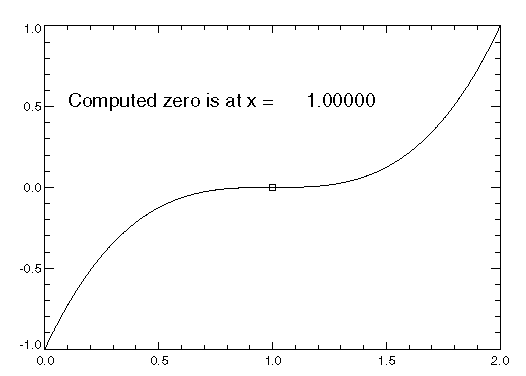The IMSL_ZEROFCN function finds the real zeros of a real function using Müller’s method.
This routine requires an IDL Advanced Math and Stats license. For more information, contact your sales or technical support representative.
The IMSL_ZEROFCN function computes n real zeros of a real function f. Given a user-supplied function f(x) and an n-vector of initial guesses x0, x1, ..., xn–1, the function uses Müller's method to locate n real zeros of f. The function has two convergence criteria. The first criterion requires that | f (xi(m)) | be less than ERR_ABS. The second criterion requires that the relative change of any two successive approximations to an xi be less than ERR_REL. Here, xi(m)) is the m-th approximation to xi. Let ERR_ABS be denoted by e1, and ERR_REL be denoted by e2. The criteria can be stated mathematically as follows. IMSL_ZEROFCN has two convergence criteria; 'convergence' is the satisfaction of either criterion.
Criterion 1:

Criterion 2:

'Convergence' is the satisfaction of either criterion.
Example
This example finds a real zero of the third-degree polynomial:
f(x) = x3 – 3x2 + 3x – 1
The results are shown in in the figure that follows.
.RUN
return, x^3 - 3 * x^2 + 3 * x - 1
END
zero = IMSL_ZEROFCN('f')
PLOT, x, f(x)
OPLOT, [zero], [f(zero)], Psym = 6
XYOUTS, .5, .5, 'Computed zero is at x = ' + $
STRING(zero(0)), Charsize = 1.5

Errors
Warning Errors
MATH_NO_CONVERGE_MAX_ITER: Function failed to converge within ITMAX iterations for at least one of the N_ROOTS roots.
Syntax
Result = IMSL_ZEROFCN(F [, /DOUBLE] [, ERR_ABS=value] [, ERR_REL=value] [, ETA=value] [, EPS=value] [, INFO=array] [, ITMAX=value] [, N_ROOTS=value] [, XGUESS=array])
Return Value
An array containing the zeros x of the function.
Arguments
F
Scalar string specifying a user-supplied function for which the zeros are to be found. The F function accepts one scalar parameter from which the function is evaluated and returns a scalar of the same type.
Keywords
DOUBLE (optional)
If present and nonzero, then double precision is used.
ERR_ABS (optional)
First stopping criterion. A zero, xi, is accepted if | f (xi) | < ERR_ABS. Default: SQRT(ε), where ε is the machine precision
.
ERR_REL (optional)
Second stopping criterion. A zero, xi, is accepted if the relative change of two successive approximations to xi is less than ERR_REL. Default: SQRT(ε), where ε is the machine precision
ETA (optional)
Spread criteria for multiple zeros. If the zero, xi, has been computed and | xi – xj | < EPS, where xj is a previously computed zero, then the computation is restarted with a guess equal to xi + ETA. Default: 0.01
EPS (optional)
See ETA. Default: SQRT(ε), where ε is the machine precision.
INFO (optional)
Array of length N_ROOTS containing convergence information. The value INFO (j – 1) is the number of iterations used in finding the j-th zero when convergence is achieved. If convergence is not obtained in ITMAX iterations, INFO (j – 1) is greater than ITMAX.
ITMAX
Maximum number of iterations per zero. Default: 100.
N_ROOTS (optional)
Number of roots for IMSL_ZEROFCN to find. Default: 1.
XGUESS (optional)
Array with N_ROOTS components containing the initial guesses for the zeros. Default: 0
Version History